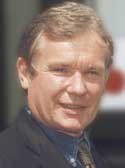
| Accommodation
|
What's On?
|
Travel
|
Webcams
Classified Ads | Local News | Photo Gallery | History Galway Arts Festival 2004 |
gmit20030204Optical telecommunications scientist to lecture at GMIT
The Galway Mayo Institute of Technology in association with the Institute of Physics have announced details this week of their intention to host a lecture by the well known technologist and inventor Professor David Payne, Director of the Optoelectronics Research Centre at the University of Southampton on the theme ‘Optical Telecommunications: Bandwidth to burn’. The lecture will take place at Galway-Mayo Institute of Technology‘s Dublin Road Campus on Monday 10th February. Professor David N. Payne, FRS is the Director of the Optoelectronics Research Centre at the University of Southampton, one of the world's best-known photonics research laboratories. He is also the Chairman and Director of Southampton Photonics Inc., a $55M fibre components start-up company. He led the team which invented the erbium-doped fibre amplifier and is responsible for many other key advances in optical fibre communications over the past 30 years. As a founder and director of York Technology and the York group of companies he won the Queen's award for technology in 1986. In recognition of his work, Professor Payne is a frequent invited speaker at major international conferences, particularly in the USA and Japan. He has won the Electronics Divisional Board Premium of the Institution of Electrical Engineers five times, the Gyr and Landis Commemorative Prize twice, the prize for the best paper at the European Conference on Optical Communication, the Tobie Award for the most significant development in fibre optics, the 1991 John Tyndall Award (USA) for his outstanding contribution to the design, measurement and fabrication of optical fibres, sensors and fibre devices, the 1991 Rank Prize for his contribution to the advancement of optoelectronics and the renowned Japanese Computers and Communications Prize. He is a Fellow of the Royal Society, the Optical Society of America and the Royal Society of Arts. In 1998, Professor Payne was awarded the prestigious Benjamin Franklin Medal (USA) for the invention of the erbium-doped optical fibre amplifier. He is one of the only individuals to have won the top European, American and Japanese prizes for optical telecommunications. He is also one of only 14 Scientists chosen to be included in the Optical Society of America Time Capsule to be opened in 2016 on the occasion of the Society's 100th Birthday celebration. In 2000 in recognition of his outstanding achievements and contributions to the international research community, Prof Payne became an original member of the world's most highly cited, influential researchers, as determined by ISI in the USA. He was also included in Barons Who's Who Millennium Edition "The European 500 Leaders for the next century". In 2001 Professor Payne was awarded the 2001 Basic Research Award by the Edward Rhein Foundation, described as the foremost technology award in Europe. Admission to the lecture is free of charge and will commence at 4pm. Related Links
|